The Roadster Challenge
A Model Eliciting Activity for second graders
Model Eliciting Activities (MEAs) are pedagogical approaches that allow teachers to integrate multiple subjects into creative multi-day learning experiences that captivate students’ curiosity and engage them in real-life problem solving (Figure 1). MEAs are known in the fields of mathematics and engineering (Gilat and Amit 2014), but despite their ability to integrate mathematics, ELA, science content, and process skills, are a relatively novel idea in elementary schools. The ability to tailor MEAs by pairing teacher-selected ELA and mathematics skills with science content to meet the needs of the class makes them a worthwhile primary grade instructional strategy.
This MEA was allotted two 45-minute classroom periods over two consecutive days. The teacher heterogeneously grouped students into teams of three. Teams worked cooperatively to reach consensus on all points of the activity. The MEA was completed as a culminating experience to a second-grade unit on force and motion. Students were informally assessed as the teacher spoke with each team and more formally assessed using a performance rubric that reflected task completion and allowed space for individualized feedback (see Supplemental Resources).
An Introduction to Model Eliciting Activities
Model Eliciting Activities utilize an engineering design process (Engineering is Elementary 2018) and present openended problems situated within a real-world context. MEAs encapsulate some of the ideas expressed in A Framework for K–12 Science Education as they create excitement about scientific thinking and promote the building and revising of knowledge during the teacher-selected activity (NRC 2012). MEAs are designed in such a way that each activity addresses several components of the three dimensions of the Next Generation Science Standards (NGSS). The ability to integrate multiple NGSS dimensions within one activity allows teachers to create a nicely packaged, sequential series of learning opportunities and discussions that makes working with MEAs relatively easy to do. Further, the open-ended, circular problem-solving strategy may allow elementary students who have begun to underperform or self-identify as “bad” in science an opportunity to joyfully reengage with science (Cunningham 2018).
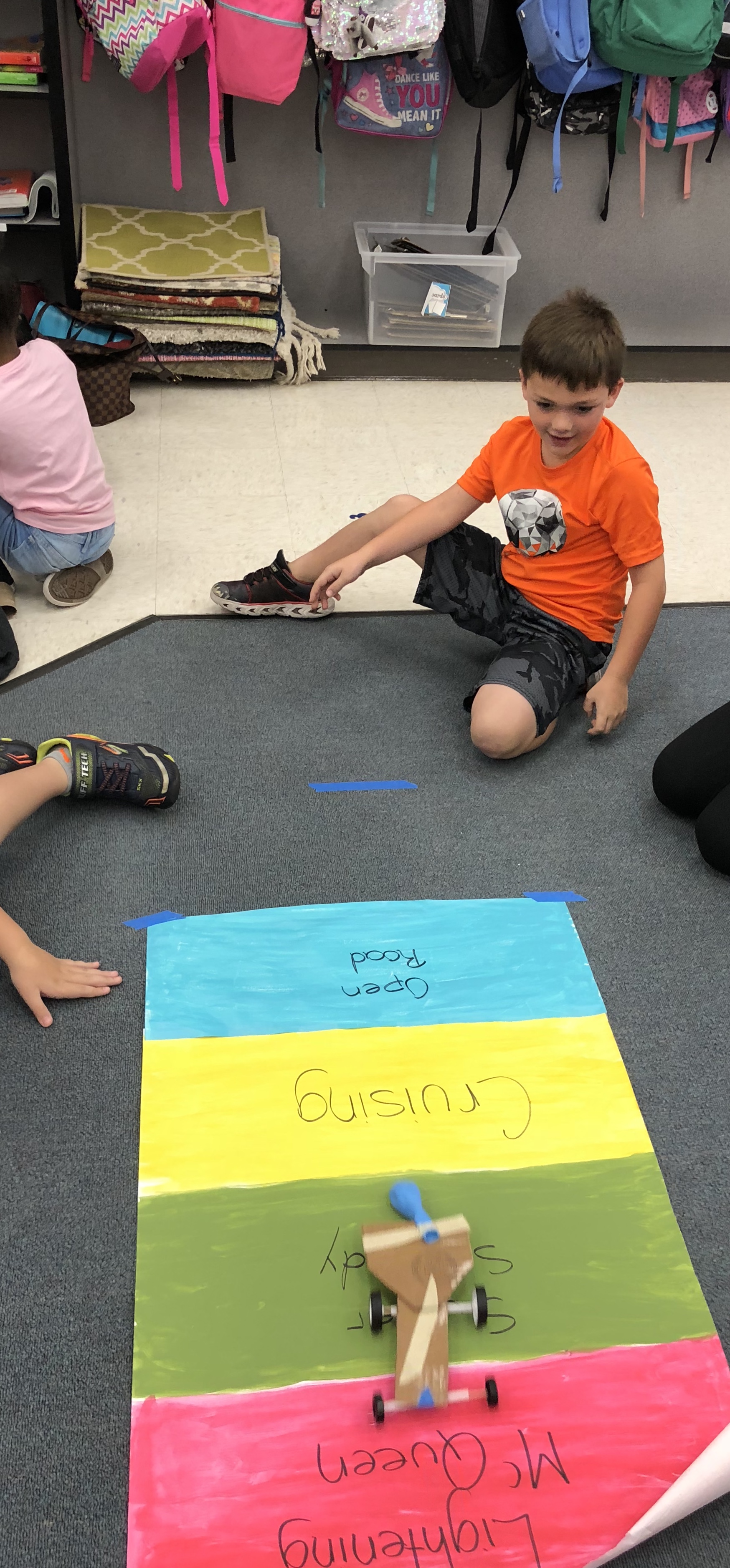
Day 1: Getting Started
The activity began with a read-aloud of Forces Make Things Move (Bradley 2005). The teacher posed both ELA and sciencebased questions about the genre of the book and the author’s purpose. She also challenged students to connect the content with previously discussed classroom experiences. For example, when reading about varying amounts of force, she asked students to connect that to a classroom discussion of kickball and how one must kick the ball to get around all the bases. Using the text to provide evidence of forces, pushes, and pulls linked the ELA standards and science content and served as a conceptual review. The activity progressed with the reading of the client letter (Figure 2). Situated within the client letter was the real-world task students were asked to address: design a vehicle to stop at the designated spot of the provided racetrack.
Materials for this activity were gathered from existing home and classroom supplies. Shipping boxes were repurposed for the vehicle frame and wheels from a derby car kit were reused. Approximate cost, per supply bag, was $2. Before letting teams begin their brainstorming, the teacher reviewed the materials in each supply bag, named them, and modeled some questions students might ask within the team to facilitate the engineering design process:
We have wheels. Oh, wait, we have different size wheels. I wonder what I could do with these? I see we have some cardboard. In fact, it is different sizes. I wonder if the size of the cardboard will influence how hard the vehicle needs to be pushed to move along the track? Oh boy, I see some play dough, some tape, and some Styrofoam. We will really need to think about how all these pieces can work together to build the vehicle
Ms. P. distributed the supply bags, reminded students of expectations, and let teams brainstorm, build, and test their vehicle. Next, students were told to record its design on the Roadster Challenge Report. Then students were to test their vehicle along the racetrack. Each group worked at their own pace and Ms. P. guided students to be mindful of passing time. These gentle reminders help students find consensus for design and moved the activity forward.
During the test sessions, Ms. P. spoke with each team and informally assessed their understanding of construction materials, force, and motion. She used a rubric to record both general and individualized feedback. Students’ written reports supported rubric documentation. Daily, at the conclusion of the activity, reports were collected and reviewed. Students’ written report was paired with the rubric to note feedback under the “Things to Think About.” For example, one student wrote his test results on the client letter instead of the report, so the teacher reminded, “Copy the test data onto the report sheet. Graph your results” on the rubric.
Teacher: Dane, I watched your test and your vehicle stopped in the Open Road zone. Drew, your vehicle stopped in the Just Cruising zone. Why? (Science and Engineering Practice: Analyze and Interpret Data)
S: We didn’t push it the same.
T: Tell me more.
S: I think I pushed harder so mine went further. (Crosscutting Concept: Cause and Effect)
T: Yes. That’s right. But did it go far enough?
S: No.
T: So what are you going to do about it?
S: Push harder.
T: Good, but remember, you need to land in the Super Speedy zone, so control the force you use.
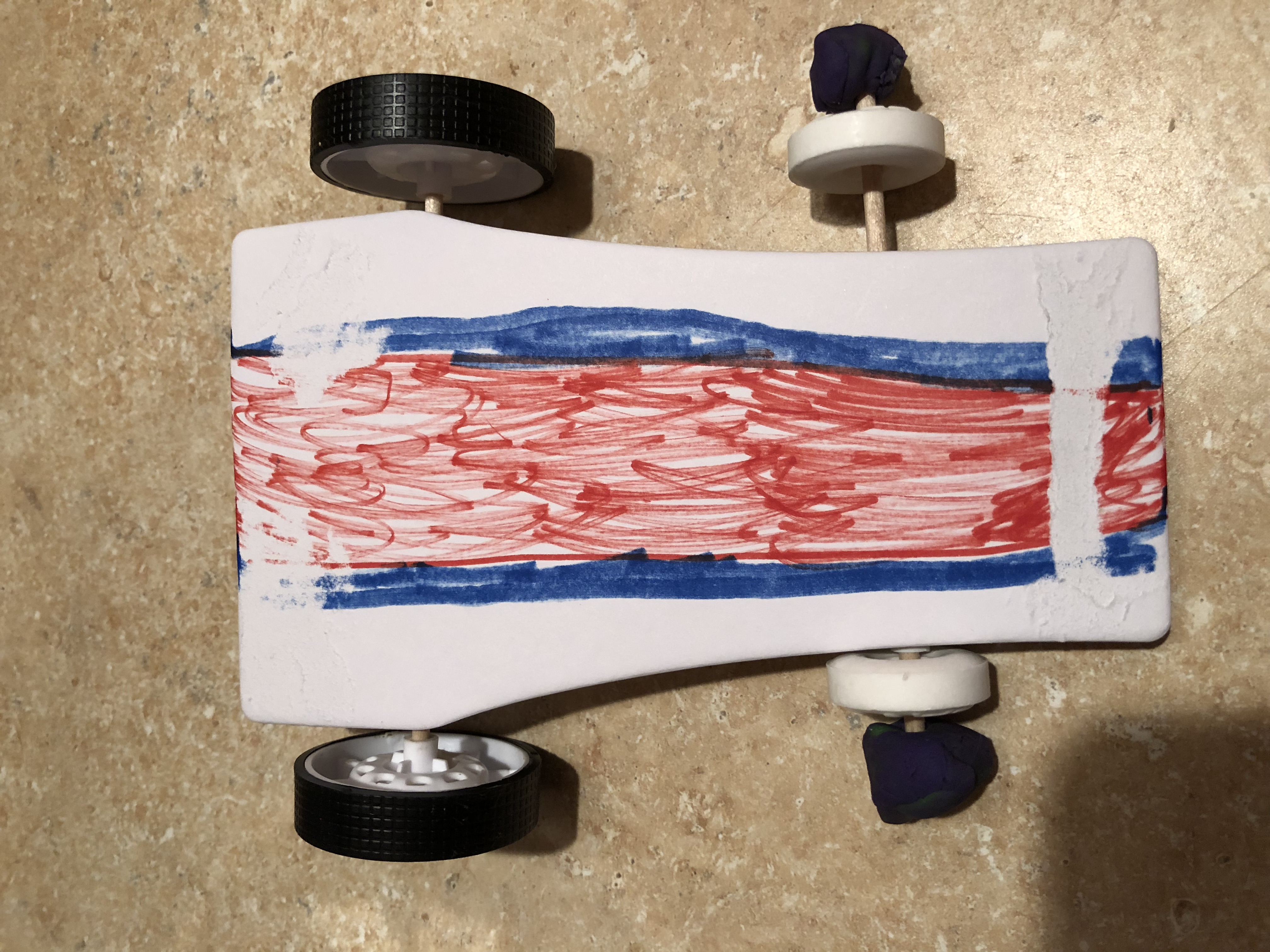
Unexpected Design Challenges
The most common challenge for students was determining how to attach the wheels to the material used as a frame. Students understood how to attach the wheels to the axle (wooden dowel), but attaching the dowel to the frame was problematic. As soon as the students taped the dowel to the frame, the axle would not spin. Students were stumped.
S: These wheels are too wiggly.
S: Let’s try to tape them. (Tapes wheels to axle and tests vehicle.)
S2: Well that’s no good. They can’t spin with tape.
Ms. P intentionally let students ponder possible solutions before referencing the play dough and asking, “I know play dough can be sticky. I wonder what you can do with this?” Students determined using play dough inside the wheel would help the axle fit more snugly while allowing the wheels to turn, but not fall off. (Crosscutting Concept: Cause and Effect)
Most teams quickly determined that the design of the vehicle impacted how the axle moved. One group decided to use a Styrofoam block as a frame.
T: How will you attach the wheels to the frame of the vehicle?
S: We are gonna poke holes through it. (Disciplinary Core Ideas: Structure and Properties of Matter)
(She intentionally withheld comments about the axle needing space to spin, but then circled back.)
T: How is it going?
S: Good. At first it was stuck, but we wiggled the stick (dowel) to make the holes bigger and now it works.
Teacher Responsibilities
- Find/create MEA based on science content.
- Situate content in a real-world setting by reading aloud or providing literature on the selected topic to the class.
Student Responsibilities
- Receive a content-based problem statement embedded in a letter from a fictitious client.
- Develop a model in response to problem statement/client letter.
- Test model.
- Compose a written response, using evidence from literature and model testing, to explain how model addresses problem posed in client letter.
- Receive a second letter (a twist) where the fictitious client adds additional information or modifies initial problem.
- Redesign and test model in response to new information.
- Compose a written response, using evidence, to explain how model addresses problem posed in client letter.
- Present final model and justification to class.
Testing Trials
The students demonstrated an understanding that varying the material and force would impact the movement of the vehicle.
S: I really want to win. Can we tape the balloon to the car to make a force?
T: Sure you can do that. (Teacher reminded students of safety requirements and stated, “The balloons are tools, not toys. Be respectful of that.)
S: Okay! (Inflates balloon, attaches to frame and releases.)
S2: It didn’t move. What happened?
S: Maybe the balloon didn’t give our vehicle enough force to move.
S3: Maybe the car is too heavy. We can try this. (Toilet paper tube as alternative frame.)
S2: I’m gonna push it and see. (Pushes the vehicle.)
S2: See. We need a different force. It works when we push by hand. (Science and Engineering Practice: Analyze and Interpret Data)
The mathematics component of this MEA was dependent on students graphing their test results. A small group of students struggled with this. Some did not graph in real time, therefore recording data was an afterthought. Other students did not notice the prelabeled tests 1, 2, 3 on the axis labels and colored in the graph incorrectly. To improve this, we did a whole-group teacher-modeled creation of a bar graph using data generated by one of the groups.
During the class discussions, we brainstormed ideas on why a vehicle went farther (push/pull/materials used to make vehicle) and what we could do with the measurement data. After a whole-group brainstorming session, small groups reviewed their reports and determined how they would change their design to make the car travel farther.
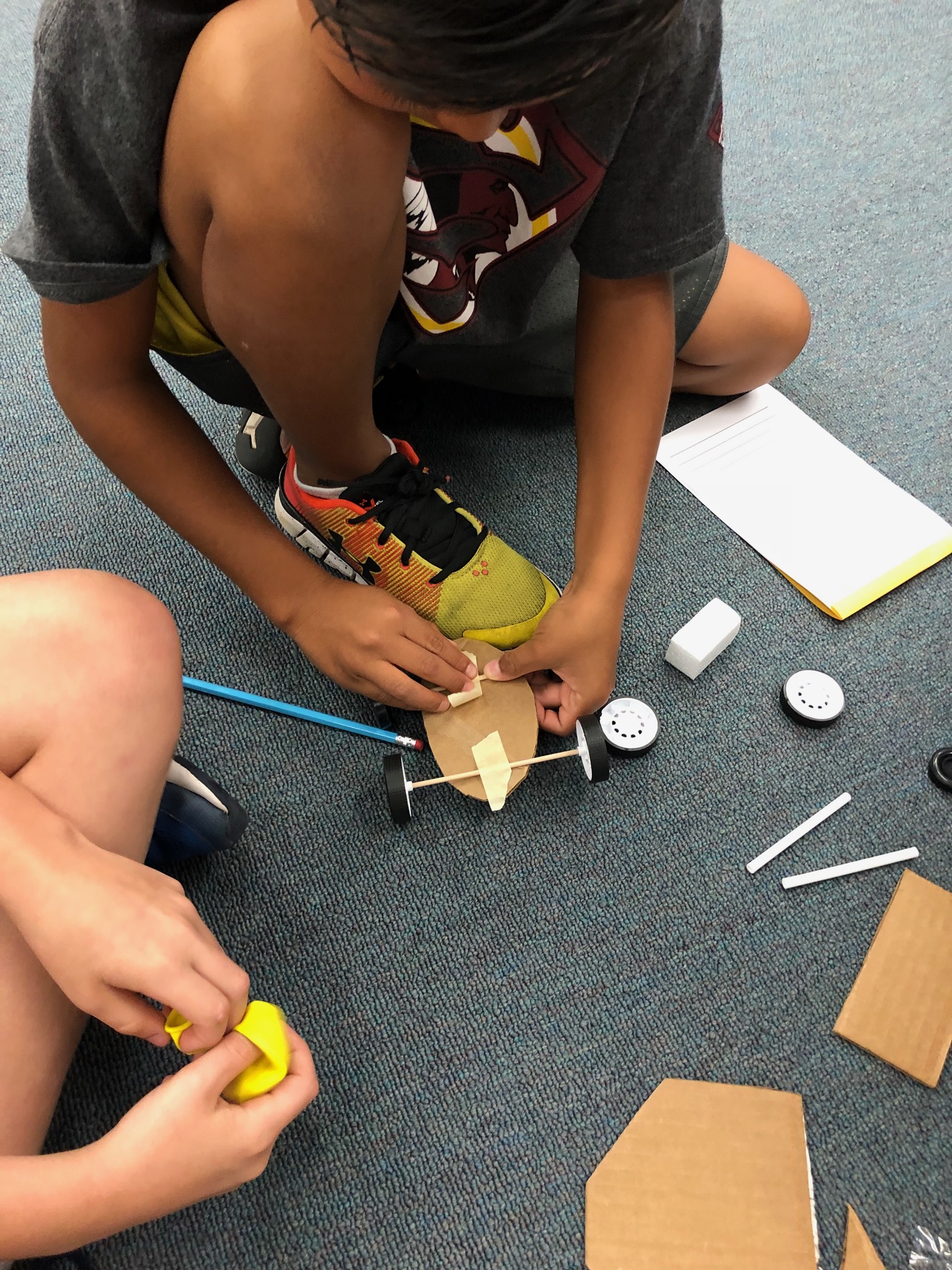
Writing Reports
MEAs incorporate opportunities for students to write responses to the fictitious client. Second-grade students have not yet been introduced to formal letter writing, so Ms. P. created a Roadster Challenge Report where each student recorded test data and responded to teacher-created questions about the activity, which provided evidence of science conceptual understanding and developing application of ELA skills.
Some students articulated thoughts about the activity, but struggled to put those ideas into formal, data-supported written sentences. Ms. P. chose to differentiate student products and extended her oral conversation with some students. By assessing understanding during an informal conversation, she was able to document conceptual knowledge on the rubric and give specific feedback.
S (oral): For this one (responding to second client letter) we added more to the car so it would be heavier. We wanted to stop in the Cruising zone, so we thought it would go slower if we had more weight.
Day 2: The Twist
The second 45-minute session began with a recap of the initial client letter and problem posed. The teacher then read Michaels’ Racing Machine (Lowery 2014) and again wove together ELA skills and science content. While reading this text, she purposefully asked students to compare the experiences in Michael’s story to that of the previously read Forces Make Things Move. Following the read-aloud, Ms. P. reviewed materials, science concepts, and expectations for completing the written report before reading aloud client letter 2 (Figure 3), which contained an unexpected “twist” that asked students to redesign the vehicle to stop in one of two specifically designated zones of the track, “Just Cruising” or “Lightning McA student works on attaching his wheels to a vehicle. Queen.” This required students to either increase or decrease the distance traveled by altering the construction materials and varying the applied force accordingly.
Just Cruising or Lightning McQueen?
S: We want to go super-fast and stop in Lightning McQueen.
T: How are you going to do that?
S: We needed to make it more aerodynamic.
T: What does aerodynamic mean?
S: To go faster.
T: OK. How will you do that?
S: I think we need more force.
T: OK. How will you give more force?
S: By adding a hot air balloon. (A regular balloon the student blew up and let the air out of to “push” the car.)
T: Sounds good. Try it. (Another group focused their redesign on the wheels.)
S: I think we need to use smaller wheels.
T: What will that do?
S: Well, if the wheels are smaller there will be less weight holding down the car and it’ll go farther.
Presenting Work
After the conclusion of the testing, student teams presented their designs to their classmates and explained the success of their design. Students proudly shared their design and boldly stated their success or shortcomings. Throughout the presentations, Ms. P. probed teams to expand their responses and use data collected from their report to support claims.
Lessons Learned
Science. Students understood the materials used to construct their vehicle and the amount of force would affect the distance traveled. They did not understand (nor is it part of the second-grade standards) the other variables that may impact the travel of the vehicle.
Math. Despite previous classroom experience with graphs, students struggled to properly graph the distance the vehicle traveled. I believe this has to do with the setup of the challenge report. A simple way to address this is to make three separate graphs for each trial and model how to graph the trials. Another improvement to data collection would be to mark distances (in inches) on the side of the track.
ELA. The intention of the Roadster Challenge Report was twofold. It housed students’ data and served as evidence of their ability to write informative pieces. Going forward, open-ended questions will be posed and composing evidence-based responses will be explicitly modeled using student-generated responses. Additionally, more concise modeling of the use of key scientific vocabulary throughout the writing will be beneficial. To further differentiate, the report could have a version that included teacher-provided diagrams and sentence stems. The modified report would support students in need of assistance expressing their conceptual understanding without struggling with the written discourse.
Teamwork. Small group work can be challenging. One group had difficulty reigning in their enthusiasm for building and testing. They were so busy building and testing, they forgot to record test data. When prompted by the teacher and reminded to record, the students happily completed their report.
Initially, there were concerns about bossy behavior and students being left out during MEA. The level of cooperation and collaboration witnessed was delightful. This was particularly heartwarming when some of the more reserved students shared ideas with classmates and those classmates were supportive.
S: Let’s try these wheels
S: That’s great idea.
S: Let’s put this on top and see if it will go slower.
S: That’s a super smart idea.
MEAs’ blend of multiple subject areas allowed daily allotted science instructional time to be expanded. With addressing so many content areas in one activity, the cross-curricular connections created meaningful learning experiences. The students regularly ask, “When are we going to do another activity like the roadsters?”
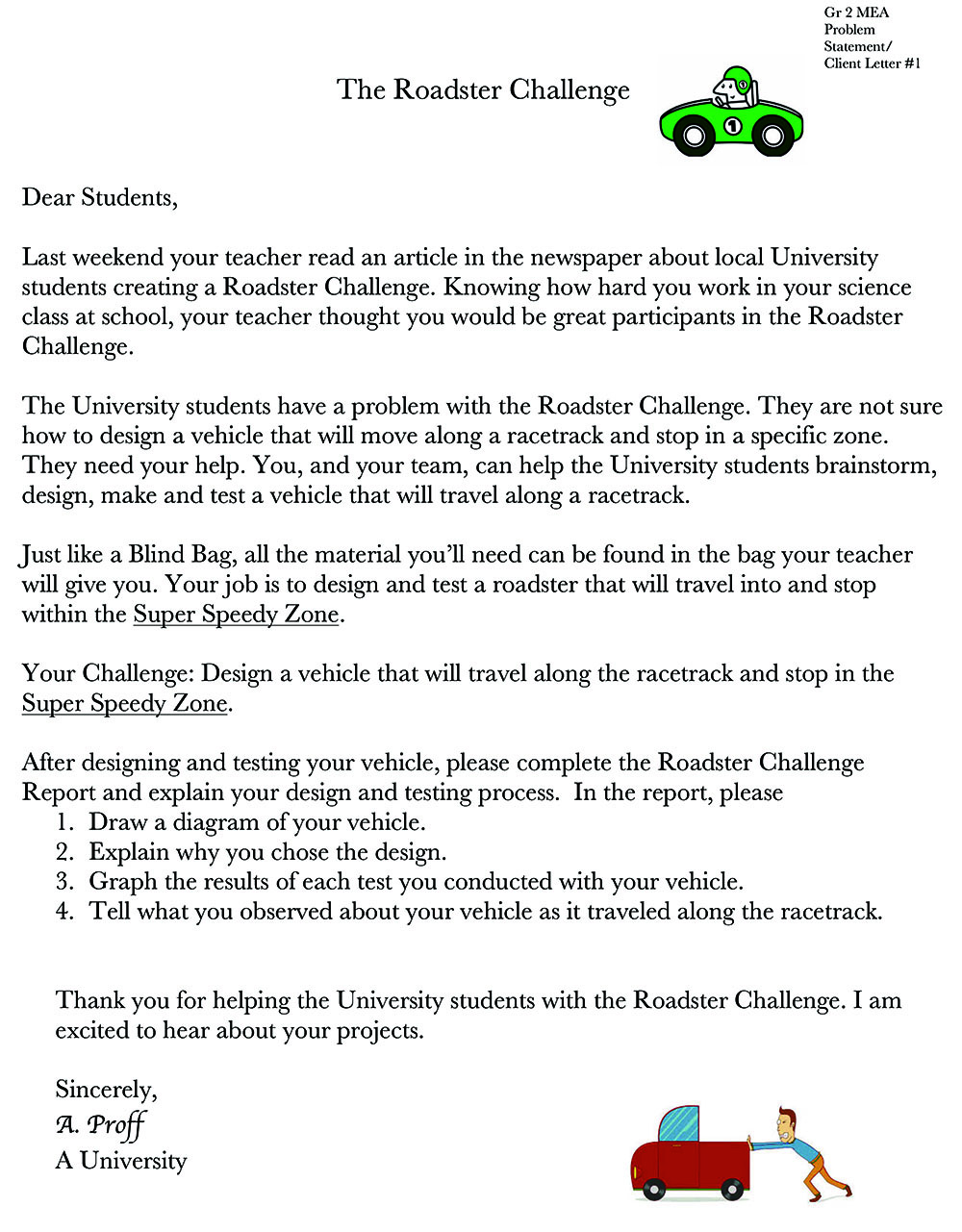
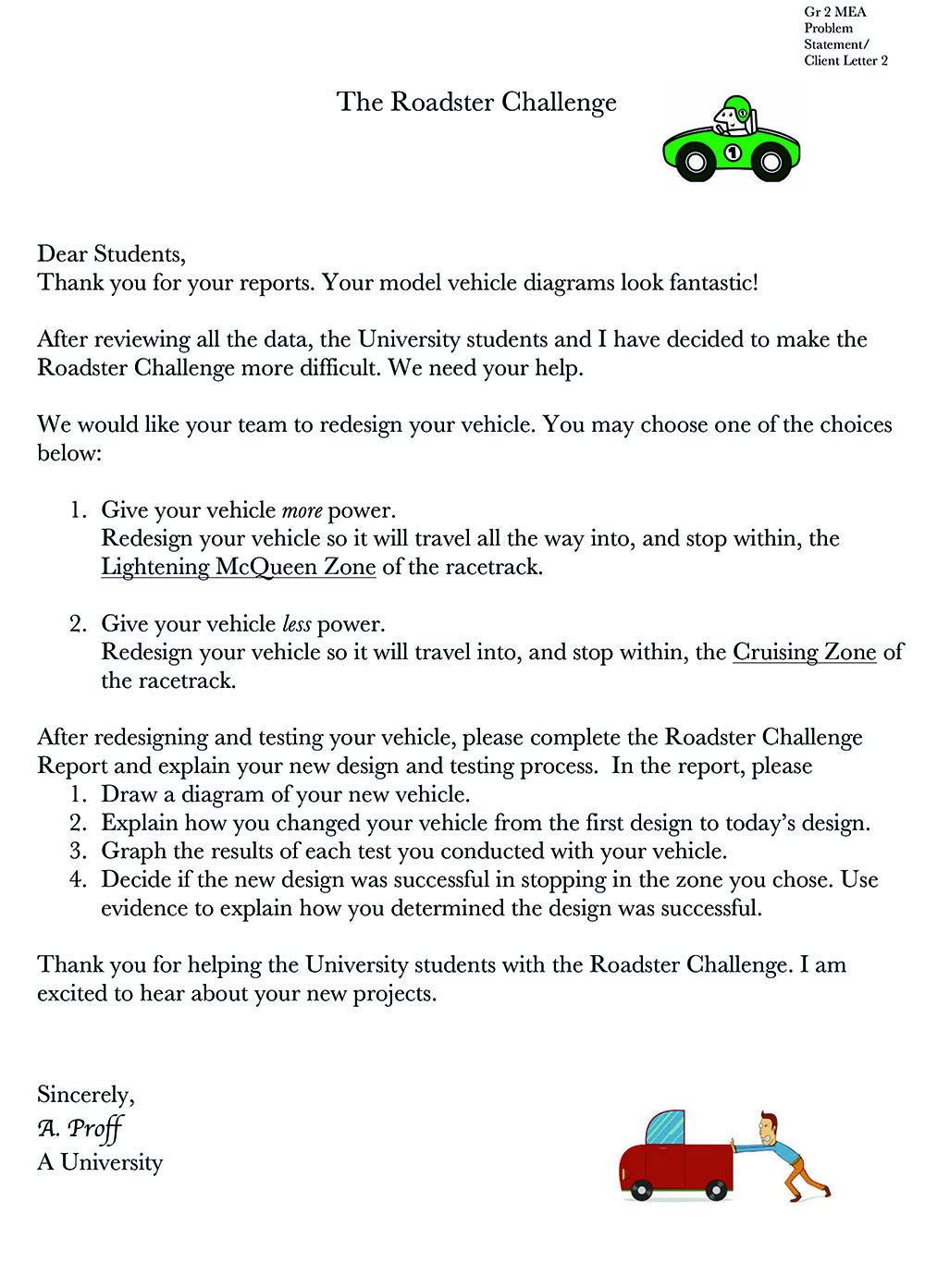
Melissa Parks (mparks@stetson.edu) is an assistant professor at Stetson University in DeLand, Florida.
Engineering Physical Science Elementary Grade 2


